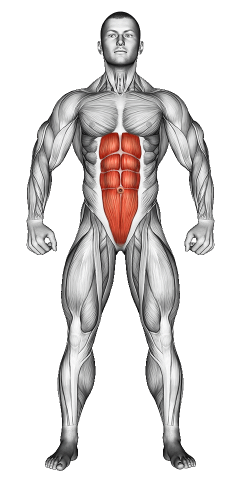V Sit Ups: Video Tutorial & Exercise Guide

Written By: Claude Michael
Updated: Oct 13, 2024
| Workout | V Sit Ups |
| Primary Muscle Group | Abs |
| Equipment Required | Bodyweight |
| Force Type | Pull |
| Mechanics | Isolation |
| Exercise Type | Strength |
| Difficulty | Intermediate |
V Sit Ups: Video Tutorial & Exercise Guide
V Sit-Ups: Step-by-Step Guide
- Step 1: Lie flat on your back with your legs extended and arms stretched overhead. Engage your core and press your lower back into the floor.
- Step 2: Simultaneously lift your upper body and legs off the ground, reaching your hands towards your toes as you form a “V” shape with your body.
- Step 3: Keep your legs as straight as possible, engaging your core to lift your chest towards your thighs.
- Step 4: Lower your arms and legs back down to the floor in a controlled manner, returning to the starting position without letting your feet or shoulders touch the ground.
- Step 5: Repeat the movement for the desired number of reps, focusing on using your core to lift and lower your body.
V Sit-Ups: Overview
V Sit-Ups are an advanced core exercise that targets the entire abdominal region. By lifting both your upper body and legs simultaneously, you challenge your rectus abdominis, obliques, and hip flexors, improving strength and endurance in your core.
This movement not only helps to build a strong, defined core but also enhances balance, coordination, and overall body control. V Sit-Ups are an excellent choice for those looking to intensify their core workout and improve their athletic performance.
V Sit-Ups: Benefits
V Sit-Ups engage your entire core, making them highly effective for building strength and definition in the abdominal muscles. The movement also targets the hip flexors, helping to improve mobility and flexibility in the lower body.
This exercise improves overall body control and coordination, as you need to synchronize the movement of your upper and lower body while maintaining balance and stability.
V Sit-Ups are a challenging exercise that helps develop endurance in your core, making it easier to perform other complex movements and maintain a stable posture during dynamic activities.
V Sit-Ups: Pro Tips & Advanced Techniques
To perform V Sit-Ups effectively, focus on controlled movements and avoid using momentum to lift your body. Keep your legs as straight as possible and engage your core throughout the entire exercise. For an added challenge, you can hold a weight or medicine ball in your hands or place ankle weights on your legs. Ready to build a strong, defined core? Let’s get to work with V Sit-Ups!
V Sit-Ups: Progression Plan
Beginner
Intermediate
Advanced
V Sit Ups: Frequently Asked Questions (FAQs)
What muscles do V Sit-Ups target?
+V Sit-Ups primarily target the rectus abdominis (six-pack muscles) and obliques, while also engaging the hip flexors and lower abs for stabilization.
Are V Sit-Ups suitable for beginners?
+V Sit-Ups can be challenging for beginners, but they can modify the exercise by bending their knees or reducing the range of motion. Start slow and focus on maintaining control.
How can I make V Sit-Ups more challenging?
+To increase the difficulty, hold a weight or medicine ball in your hands, or use ankle weights to add resistance. You can also slow down the movement to increase time under tension.
How often should I include V Sit-Ups in my workout?
+Incorporate V Sit-Ups 2-3 times a week as part of your core workout. They pair well with other lower and upper ab exercises to provide a complete core challenge.
What common mistakes should I avoid?
+Avoid using momentum to lift your body and ensure that you keep your legs as straight as possible. Focus on controlled movements and engaging your core throughout the exercise.
Share
Don’t Wish for It, Work for It – Join the FlexXP Newsletter Today!
Thank you for signing up for the FlexXP Newsletter!
This site is protected and the Google Privacy Policy and Terms of Service apply.
